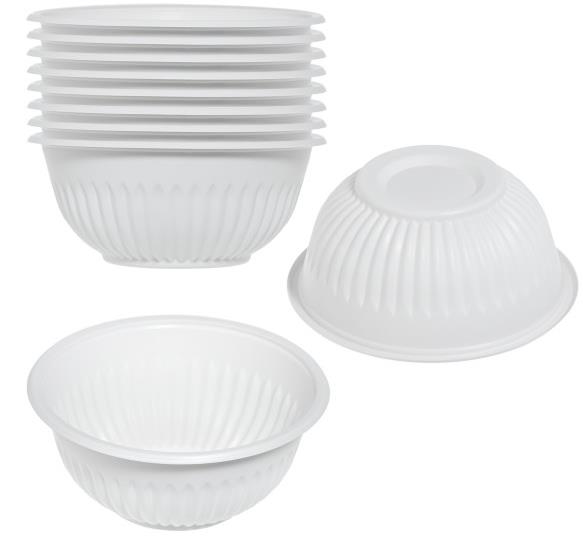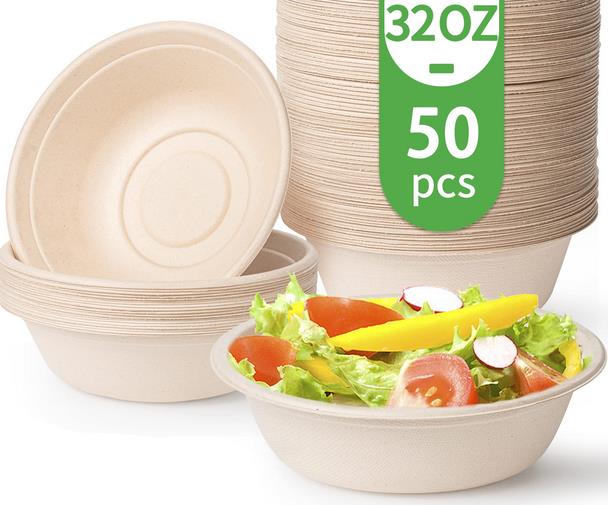
Content Menu
● Understanding Disposable Plastic Bowls
>> Material Composition
● The Environmental Impact of Plastic Bowl Disposable Products
>> 1. Longevity in Landfills
>> 2. Recycling Rates
>> 3. Carbon Footprint
● Eco-Friendly Alternatives to Plastic Bowls
● Consumer Behavior and Education
● Industry Innovations
● Legislation and Policy Changes
● Challenges in Transitioning Away from Plastics
● The Role of Businesses in Promoting Sustainability
● Consumer Trends Towards Sustainability
● Future Outlook on Disposable Plastics
● Conclusion
● FAQ
>> 1. Are all disposable plastic bowls recyclable?
>> 2. What are biodegradable bowls made from?
>> 3. How long does it take for biodegradable bowls to decompose?
>> 4. Is it better to use reusable dishes instead of disposable ones?
>> 5. What should I look for when choosing eco-friendly disposable products?
In today's world, the conversation surrounding sustainability and environmental responsibility has become increasingly crucial. As consumers become more conscious of their choices, the demand for eco-friendly products has surged. Among these products, disposable plastic bowls have garnered attention for their convenience and potential environmental impact. This article delves into the eco-friendliness of plastic bowl disposable products, focusing on their material composition, recyclability, and overall environmental footprint.

Understanding Disposable Plastic Bowls
Disposable plastic bowls are widely used in various settings, including restaurants, catering services, and home dining. They are primarily made from materials like polypropylene (PP) and polystyrene (PS). While these materials offer convenience and durability, they also raise concerns regarding their environmental impact.
Material Composition
- Polypropylene (PP): This thermoplastic polymer is known for its strength and heat resistance. It is often used in food packaging due to its ability to withstand high temperatures without releasing harmful chemicals. PP is recyclable, making it a more sustainable option compared to other plastics.
- Polystyrene (PS): Commonly used for disposable tableware, PS is lightweight but poses significant environmental challenges. It is not widely recycled and can persist in the environment for hundreds of years.
The Environmental Impact of Plastic Bowl Disposable Products
The environmental impact of disposable plastic bowls can be assessed through various factors:
1. Longevity in Landfills
Plastic bowls made from PS can take centuries to decompose in landfills. This long lifespan contributes to the growing issue of plastic pollution, particularly in oceans where marine life is adversely affected by plastic debris. The Great Pacific Garbage Patch is a stark example of how plastics accumulate in the ocean, posing threats to marine ecosystems.
2. Recycling Rates
While PP is recyclable, the reality is that only a small percentage of plastic waste is actually recycled. According to studies, approximately 9% of all plastic produced globally is recycled. This low recycling rate highlights the inefficiency of current waste management systems and the need for improved recycling infrastructure.
3. Carbon Footprint
The production of disposable plastics involves significant energy consumption and greenhouse gas emissions. The extraction of fossil fuels used in plastic manufacturing contributes to climate change. However, some argue that the carbon footprint of producing biodegradable alternatives can also be high, complicating the comparison between different types of disposables.
Eco-Friendly Alternatives to Plastic Bowls
As awareness grows about the environmental impact of single-use plastics, many consumers are seeking alternatives that offer similar convenience without compromising sustainability. Here are some eco-friendly options:
- Biodegradable Bowls: Made from materials like sugarcane fiber or bamboo, these bowls break down naturally within months, reducing landfill waste significantly.
- Compostable Bowls: These products are designed to decompose into nutrient-rich compost when disposed of correctly. They are often made from plant-based materials and do not release harmful toxins during decomposition.
- Reusable Bowls: While not disposable, reusable bowls made from glass or stainless steel offer a sustainable solution for those looking to reduce their environmental footprint.

Consumer Behavior and Education
Educating consumers about the benefits of eco-friendly alternatives is essential for driving change in purchasing habits. Clear labeling on products indicating recyclability or compostability can help consumers make informed choices. Additionally, awareness campaigns can play a pivotal role in shifting consumer behavior toward more sustainable practices.
Industry Innovations
The food service industry plays a critical role in addressing plastic waste. Many companies are now investing in research and development to create more sustainable packaging solutions:
- Innovative Materials: New materials that mimic the properties of traditional plastics but are biodegradable or compostable are emerging in the market. For instance, some companies are exploring bioplastics derived from corn starch or other renewable resources.
- Enhanced Recycling Programs: Companies are partnering with recycling facilities to improve the recovery rates of disposable plastics like PP. Initiatives such as take-back programs encourage consumers to return used products for proper recycling.
Legislation and Policy Changes
Governments around the world are recognizing the need for policy changes to address plastic pollution. Many regions have implemented bans or restrictions on single-use plastics, including disposable bowls. These legislative measures aim to reduce plastic waste and promote the use of sustainable alternatives.
- Plastic Bag Bans: Several cities have enacted bans on plastic bags, prompting consumers to seek reusable options for shopping.
- Waste Reduction Goals: Some countries have set ambitious targets for reducing overall plastic consumption by promoting recycling and encouraging businesses to adopt sustainable practices.
Challenges in Transitioning Away from Plastics
Despite the growing availability of eco-friendly alternatives, several challenges hinder a complete transition away from disposable plastics:
- Cost: Eco-friendly products often come at a higher price point compared to traditional plastics. This cost difference can deter consumers and businesses from making the switch.
- Availability: In some regions, access to biodegradable or compostable options may be limited, making it difficult for consumers to choose sustainable products.
- Consumer Habits: Changing ingrained consumer habits takes time and effort. Many people are accustomed to the convenience that disposable plastics provide, making it challenging to shift towards more sustainable practices.
The Role of Businesses in Promoting Sustainability
Businesses play a crucial role in promoting sustainability through their product offerings and practices:
- Sourcing Sustainable Materials: Companies can prioritize sourcing materials that are renewable or recycled when producing disposable items.
- Transparency: Providing information about sourcing practices and environmental impacts can help build consumer trust and encourage responsible purchasing decisions.
- Corporate Social Responsibility (CSR): Many businesses are adopting CSR initiatives focused on reducing their environmental impact through waste reduction strategies and community engagement programs.
Consumer Trends Towards Sustainability
Recent studies indicate that consumers are increasingly prioritizing sustainability when making purchasing decisions:
- Demand for Transparency: Consumers want to know where their products come from and how they impact the environment. Brands that provide clear information about their sustainability efforts tend to attract more customers.
- Preference for Eco-Friendly Products: Surveys show that a significant portion of consumers would choose eco-friendly options even if they cost slightly more than conventional products.
- Influence of Social Media: Social media platforms play a vital role in shaping consumer perceptions about brands' sustainability efforts. Positive reviews and endorsements from influencers can significantly boost sales of eco-friendly products.
Future Outlook on Disposable Plastics
As awareness about environmental issues continues to grow, it is likely that regulations surrounding disposable plastics will become stricter:
- Increased Research Funding: Governments may allocate more funding towards research focused on developing sustainable materials that can replace traditional plastics effectively.
- Global Cooperation: International agreements may emerge aimed at reducing plastic waste globally, encouraging countries to adopt similar policies regarding single-use plastics.
Conclusion
In conclusion, while disposable plastic bowls offer convenience, their environmental impact cannot be overlooked. The longevity of certain plastics in landfills and low recycling rates pose significant challenges for sustainability efforts. However, with advancements in material science and increased consumer awareness, there are viable alternatives available that can mitigate these issues.
By choosing biodegradable or compostable options and supporting companies committed to sustainability, consumers can help reduce their ecological footprint while still enjoying the convenience that disposable products provide.

FAQ
1. Are all disposable plastic bowls recyclable?
Not all disposable plastic bowls are recyclable. While polypropylene (PP) bowls can be recycled in some areas, polystyrene (PS) bowls typically cannot be recycled due to limited facilities accepting them.
2. What are biodegradable bowls made from?
Biodegradable bowls are often made from natural materials such as sugarcane fiber, bamboo, or palm leaves. These materials break down naturally over time without leaving harmful residues.
3. How long does it take for biodegradable bowls to decompose?
Biodegradable bowls can decompose within a few months under proper composting conditions, significantly faster than traditional plastic products.
4. Is it better to use reusable dishes instead of disposable ones?
Yes, using reusable dishes is generally more sustainable than using disposables because they reduce waste significantly over time and do not contribute to landfill issues associated with single-use items.
5. What should I look for when choosing eco-friendly disposable products?
When selecting eco-friendly disposable products, look for certifications indicating biodegradability or compostability as well as clear labeling on recyclability options.

















